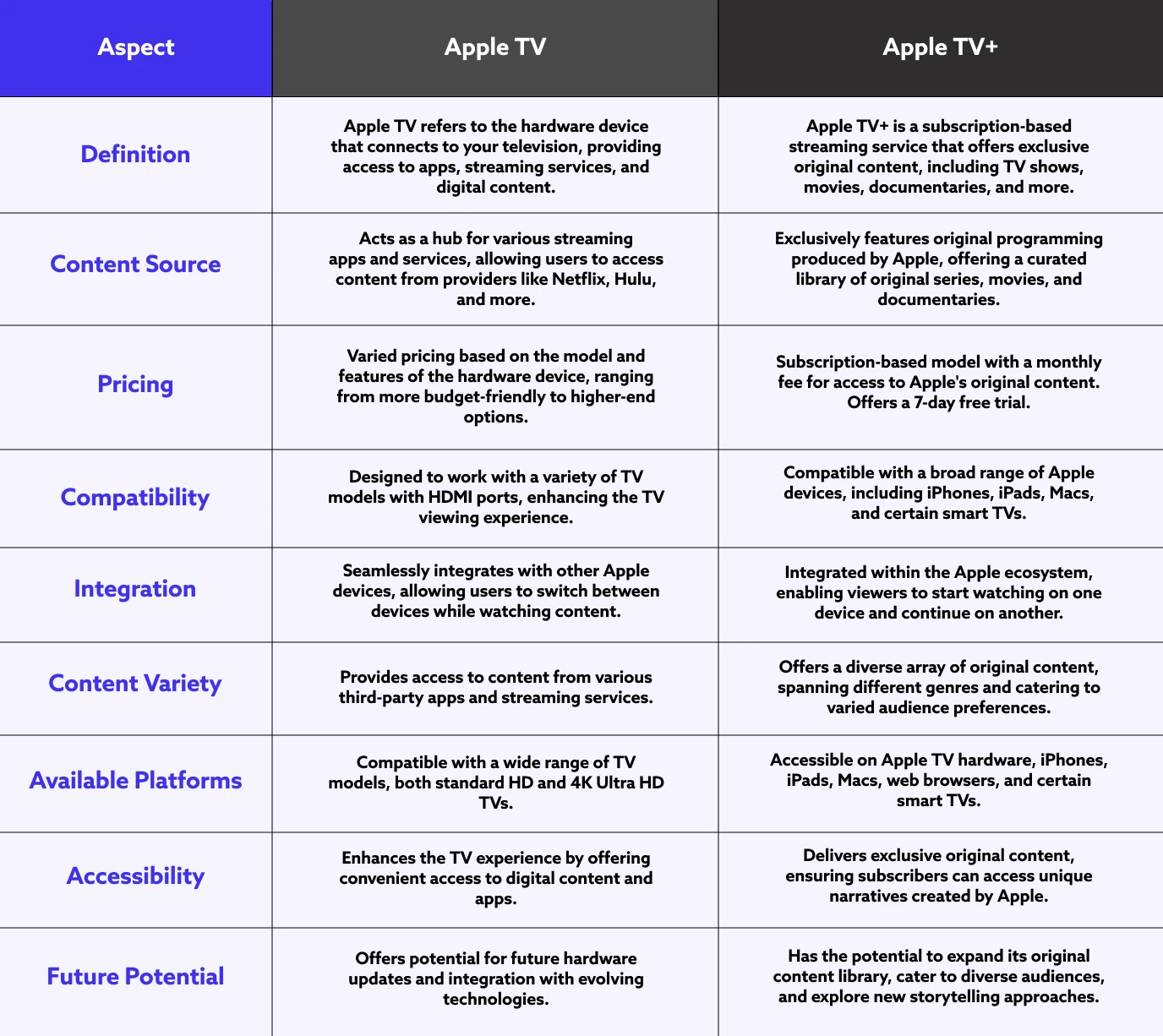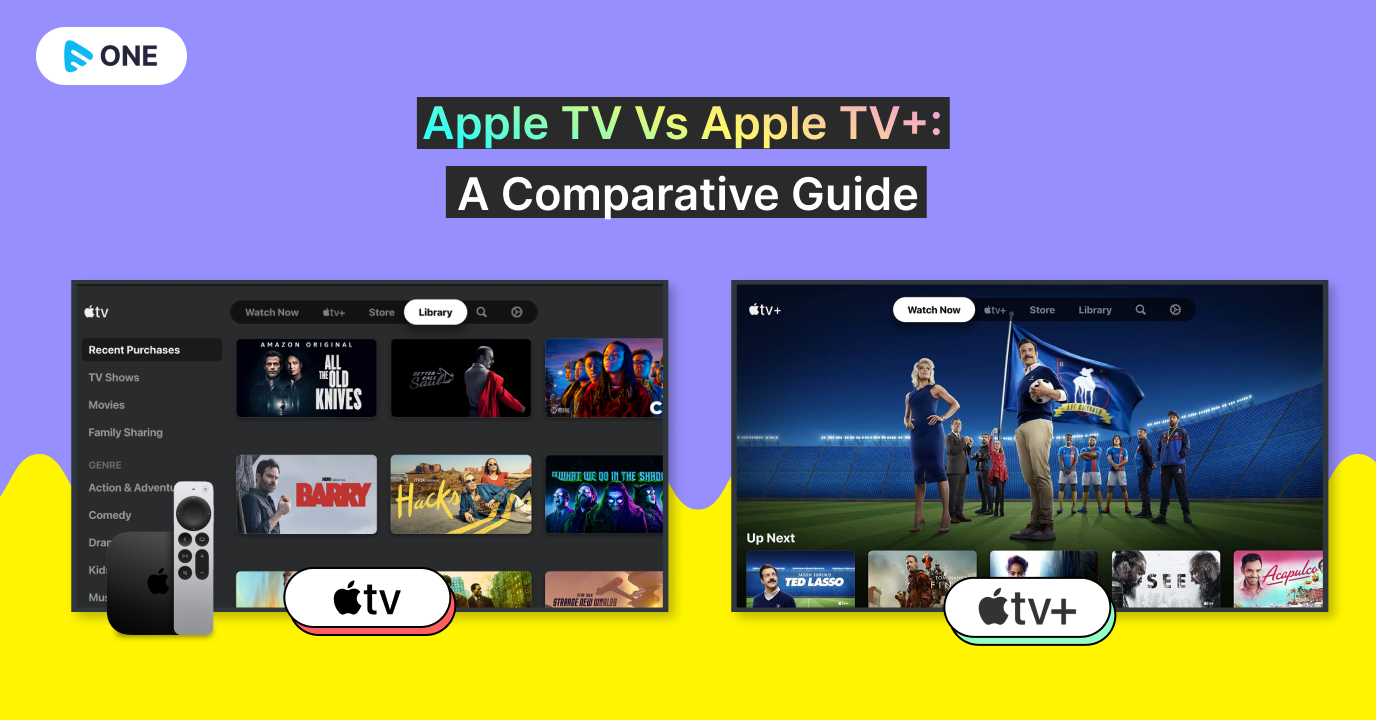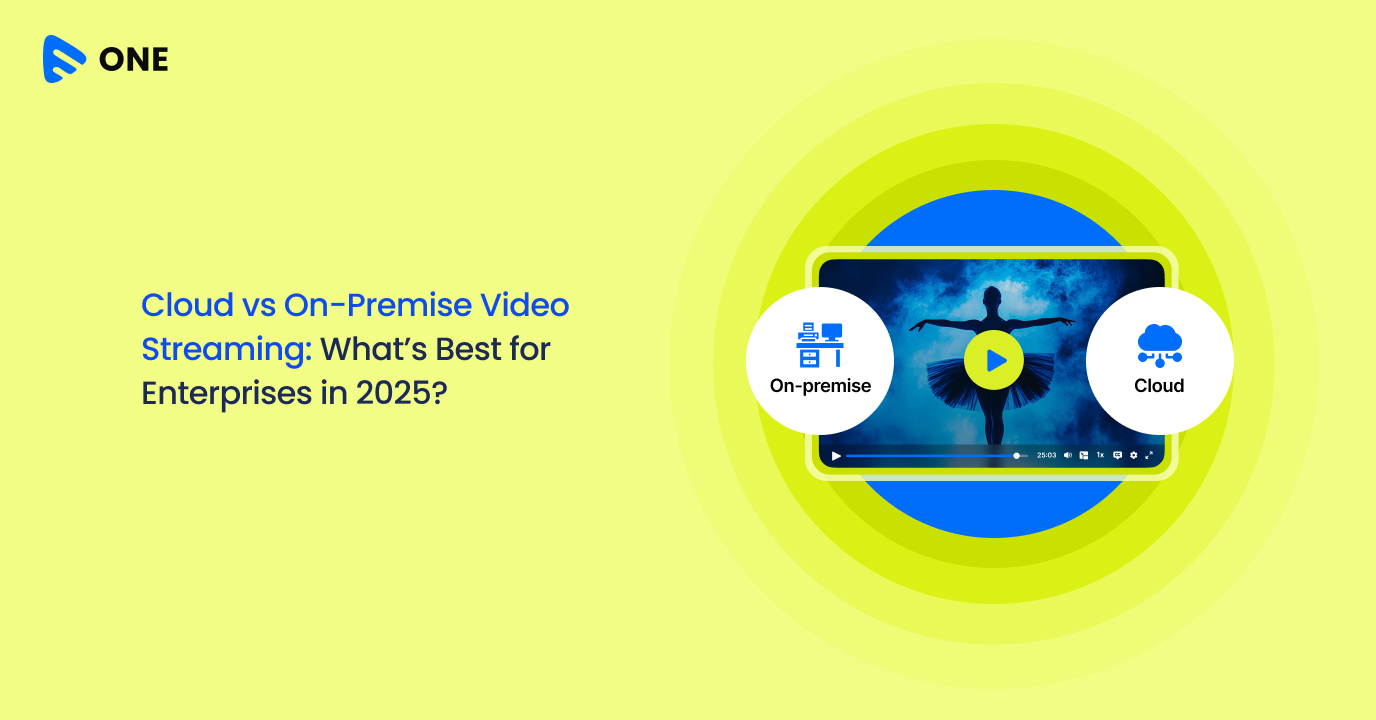What sets the stage for an engaging streaming experience – the device your audience watches on or the content that fuels their screen?
As streaming businesses seek the golden ticket to capturing audience attention, a pivotal question emerges: Is it the hardware or the content library that truly reigns supreme?
For streaming businesses striving to reach their goals, the dichotomy between Apple TV vs Apple TV+ isn’t just about choices, it’s about understanding the crucial details to cater to the success of your business success.
In this blog, we will walk you through an in-depth journey to discussing the differences between Apple TV vs Apple TV+. Streaming businesses are thrust into this captivating conundrum, where hardware prowess meets content curation. So, let’s get started!
What Is Apple TV?
Apple TV is a digital media player and streaming device developed by Apple Inc. It enables users to access a wide range of digital content, including movies, TV shows, music, photos, and videos, and stream them directly to their television screens.
Apple TV connects to a user’s television through an HDMI cable and interfaces with their existing Wi-Fi network to provide access to various streaming services, apps, and online platforms.
At its core, Apple TV serves as a hub for entertainment content, offering a user-friendly interface that allows viewers to navigate through their chosen media with ease. It is designed to enhance the television experience by integrating digital content consumption seamlessly into the living room environment.
The device comes in different models with varying capabilities, including the ability to play games, access app stores, and even interact with virtual assistants like Siri for voice-based commands and searches.
Launch Your Own Apple TV App Effortlessly With Muvi! Sign Up for a Free Trial Today!
What Is Apple TV+?
Apple TV+ is a subscription-based streaming service introduced by Apple Inc. that offers a diverse array of original content, including TV shows, movies, documentaries, and more.
Launched as part of Apple’s expansion into the streaming industry, Apple TV+ aims to provide subscribers with exclusive and high-quality entertainment directly accessible on a variety of devices.
Unlike traditional cable or satellite TV, Apple TV+ operates as an (over-the-top) OTT streaming service, which means that users can access its content via the internet without the need for a cable subscription. The platform features a growing library of original productions, spanning various genres and catering to different audiences.
Apple TV+ content is specifically curated to reflect the brand’s commitment to innovative storytelling and exceptional production values. With a focus on fostering creative collaborations and producing unique narratives, the service brings together renowned actors, directors, and creators to deliver engaging and distinctive content that sets it apart in the streaming landscape.
Subscribers can access Apple TV+ content through the Apple TV app, which is available on a wide range of devices, including iPhones, iPads, Apple TV devices, Mac computers, and select smart TVs. The service also supports offline viewing, allowing users to download content and watch it without an active internet connection.
Apple TV: Overview, History, Potential
Apple TV stands as a testament to Apple Inc.’s foray into the world of digital entertainment. It serves as a bridge between the digital and traditional realms of television, enabling users to seamlessly access a myriad of streaming content, apps, and digital services directly on their TV screens. Beyond just a hardware device, Apple TV has evolved into a comprehensive platform that redefines how audiences engage with entertainment.
Apple TV’s journey began in 2007 with its initial launch. Over the years, it has undergone several iterations, each marked by technological advancements and enhanced user experiences. From its origins as a media player with access to iTunes content, it transformed into a versatile streaming device, integrating apps, games, and even voice-activated capabilities through Siri integration. This journey culminated in the introduction of the Apple TV app and the subsequent launch of Apple TV+, the company’s own streaming service.
The potential of Apple TV is multifaceted and extends far beyond its current capabilities. As a hardware device, Apple TV continues to evolve, offering features like 4K and HDR support, advanced audio technologies, and integration with the broader Apple ecosystem. The device’s potential lies in its ability to seamlessly merge digital and traditional TV experiences, offering a unified platform for content consumption.
The integration of the Apple TV app across various Apple devices creates a cohesive entertainment ecosystem that fosters viewer engagement and convenience. This potential for cross-device synergy and a personalized viewing experience enhances Apple TV’s capability.
Apple TV+: Overview, History, Potential
Apple TV+ represents Apple Inc.’s bold stride into the competitive arena of subscription-based streaming services. Launched in 2019, Apple TV+ is not just a streaming platform; it’s a testament to Apple’s commitment to delivering original, high-quality content directly to audiences around the globe.
With an emphasis on innovative storytelling, exceptional production values, and a diverse array of genres, Apple TV+ aims to carve a distinctive niche in the streaming landscape.
The inception of Apple TV+ marked a strategic shift for Apple, expanding its focus beyond hardware and software to encompass the realm of content creation. This evolution leverages Apple’s vast resources and industry partnerships to produce original series, films, documentaries, and more. The launch of Apple TV+ was heralded by a lineup of highly anticipated shows featuring A-list talent, immediately piquing the interest of viewers and industry observers alike.
Apple TV+ possesses considerable potential that extends beyond its current offerings. The service’s potential lies in its capacity to redefine how audiences consume content, offering a curated selection of exclusive programming that reflects Apple’s reputation for innovation and quality.
With an expanding library of original content and ongoing collaborations with renowned creators, Apple TV+ has the power to attract subscribers seeking fresh narratives and immersive experiences.
Apple TV+ also has the potential to reshape industry standards. By offering a platform for original content free from ads, it taps into a consumer desire for uninterrupted storytelling. Its emphasis on quality over quantity, manifested in its carefully curated library, positions it as a haven for creators seeking to bring unique stories to life.

Apple TV Vs Apple TV+: All You Need To Know
1. Apple TV Vs Apple TV+: The Basics
Apple TV, the hardware device, serves as a conduit between your TV and a world of digital entertainment. It seamlessly connects your television to a range of streaming services, apps, and digital content.
Acting as a versatile bridge, it enables viewers to enjoy their favorite movies, TV shows, music, and more, directly on the big screen. With a user-friendly interface and integration with other Apple devices, Apple TV extends beyond mere streaming to encompass gaming, apps, and even voice-activated functionalities through Siri.
Apple TV+, on the other hand, is Apple’s venture into the realm of streaming content. It’s a subscription-based streaming service that offers a plethora of original programming, exclusive to the platform. From gripping dramas and intriguing documentaries to heart-warming comedies, Apple TV+ curates a diverse array of content, all with Apple’s signature focus on innovation and quality.
Unlike traditional TV, which often includes advertisements, Apple TV+ provides an ad-free viewing experience, allowing audiences to immerse themselves fully in the narratives.
The key differentiation between Apple TV vs Apple TV+ lies in their roles. Apple TV is the hardware that empowers you to access various streaming apps and services on your television. It serves as a gateway to digital content, enhancing your TV with a connected experience. On the other hand, Apple TV+ is a subscription service that offers exclusive original content produced by Apple. It’s a destination for immersive storytelling and compelling narratives crafted to captivate audiences.
2. Apple TV Vs Apple TV+: Content
Apple TV allows users to download and stream content from popular apps like Netflix, Hulu, HBO Max, and more. Additionally, users can access their purchased or rented content from the iTunes Store, making it a versatile hub for digital entertainment. However, it’s crucial to note that Apple TV itself does not provide its own original content.
Apple TV+, on the other hand, exclusively features original series, movies, and documentaries created by and for Apple. The content available on Apple TV+ is diverse, ranging from gripping dramas to family-friendly shows and thought-provoking documentaries. The service aims to captivate audiences with innovative storytelling, exceptional production quality, and a focus on unique narratives that resonate with viewers.
3. Apple TV Vs Apple TV+: Compatibility
Apple TV as a hardware device is designed to work with a variety of television models. It connects to your TV through an HDMI port, allowing users to enhance their TV viewing experience by accessing streaming services, apps, and digital content.
Apple TV is compatible with a wide range of TV models, including both standard high-definition (HD) TVs and 4K Ultra HD TVs. It’s important to note that the compatibility of Apple TV hardware is primarily determined by the availability of an HDMI port on the user’s TV.
Apple TV+, on the other hand, is designed to be compatible with a broader spectrum of devices. While it’s accessible through the Apple TV app on Apple TV hardware, it is not limited to this device alone. Apple TV+ is available across a range of Apple devices, including iPhones, iPads, Mac computers, and even web browsers.
This cross-device compatibility ensures that subscribers can enjoy Apple TV+ content on their preferred device, whether at home or on the go.
One of the key advantages of Apple TV+ is its seamless integration within the Apple ecosystem. Subscribers can start watching a show on their iPhone during their commute, switch to their iPad while relaxing at home, and continue on their Apple TV for a cinematic experience. This compatibility across devices enhances the convenience and accessibility of Apple TV+ content.
Apple TV+ also extends its compatibility to other smart TV platforms. In addition to Apple devices, some smart TV manufacturers offer the Apple TV app directly on their TVs, making it easier for viewers to access their favorite Apple TV+ shows without the need for additional hardware. This cross-platform approach broadens the reach of Apple TV+ and allows more users to enjoy its original content.
4. Apple TV Vs Apple TV+: Pricing
The pricing of Apple TV varies based on the model and features you opt for. Apple offers different iterations, including Apple TV HD and Apple TV 4K, each with its own set of capabilities and price points.
The Apple TV 4K is available in two models: the Wi-Fi version priced at $129.00 and the Wi-Fi+Ethernet version priced at $149.00. Apple also provides a convenient installment option, allowing you to avoid paying the full amount upfront.
For the Wi-Fi model, the monthly installment is $21.50 for 6 months, while the Wi-Fi+Ethernet model’s installment is $24.83 per month over the same period.
Apple TV+, as a streaming service, follows a subscription-based pricing model. Apple TV+ offers a 7-day free trial period, after which a monthly subscription fee of $6.99 applies. Alternatively, if you opt for the Apple One subscription, priced at $16.95/month for individuals and $22.95/month for families, you can access Apple TV Plus as part of this bundled offering.
This competitive pricing is intended to attract subscribers who are eager to access Apple’s original content library. It’s worth noting that some Apple device purchases come with a free trial of Apple TV+ for a limited time, offering users a chance to explore the service without an immediate financial commitment.
Apple has also introduced a bundle option that combines multiple Apple services, including Apple TV+. The Apple One subscription bundles together services like Apple Music, Apple TV+, Apple Arcade, and iCloud storage. This not only provides subscribers with a comprehensive entertainment package but also offers potential savings compared to subscribing to each service individually.
Apple TV Vs Apple TV+ in a Glance

The Bottom Line
For streaming businesses, understanding the nuanced differences between Apple TV vs Apple TV+ is pivotal to navigating the dynamic landscape of digital entertainment. Apple TV, as a hardware device, serves as a versatile tool to enhance the TV viewing experience, enabling users to access a plethora of streaming apps and services. This hardware-centric approach provides streaming businesses an avenue to extend their reach to audiences seeking convenience and accessibility.
On the other hand, Apple TV+ stands as a testament to Apple’s venture into content creation and original programming. It unveils a unique realm where streaming businesses can explore partnerships, collaborations, and original productions that capture the essence of innovation and creativity.
Now that we’ve delved into the realms of Apple TV and Apple TV+, it’s clear that these offerings are poised to play significant roles in the swiftly growing connected TV ecosystem. The trajectory of Apple TV’s expansion hints at remarkable growth on the horizon, especially with the recent reduction in prices, rendering it an even more accessible choice.
As the connected TV landscape evolves, seizing the opportune moment to establish your presence becomes paramount. Launching your own Apple TV app aligns with this narrative seamlessly, and Muvi One can make it a reality with unparalleled ease.
Our comprehensive solution offers built-in multi-DRM security, encoder and decoder integration, content delivery network (CDN) support, adaptive bit rate (ABR) streaming, and many more – right out of the box. With Muvi One, you can easily build your Apple TV app and take advantage of its wide user base and powerful features.
With Muvi One, you can easily launch your own branded Apple TV app. Take a 14-day free trial to get started today.



















Add your comment